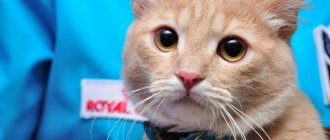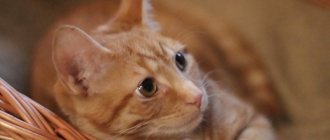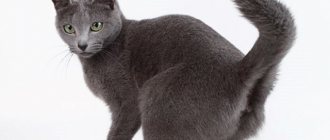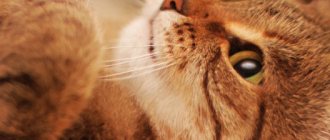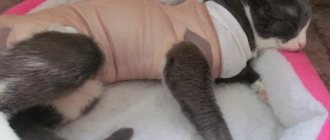12433Administration
Castration is a complex process for both the pet and its owner. After all, it is important that this procedure is quick, easy and painless. How will the cat behave after this operation? A cat's behavior after castration can be unpredictable.
But this does not always happen, sometimes everything remains the same as before the operation. But in order to be prepared for unexpected consequences, it is worth considering the characteristics of the animal’s behavior after castration.
What is castration
Castration is a medical procedure that suppresses sexual instincts.
There are two methods used in veterinary medicine:
- Surgery. Under general anesthesia, the scrotum is incised and the testes are removed. After the procedure, the hormonal background changes, the concentration of testosterone gradually decreases. The animal's reproductive instinct is suppressed, interest in females disappears, and behavior changes.
- Medical castration . This method does not require anesthesia or surgery. An implant is inserted under the skin, the active substance is gradually absorbed, reducing the level of testosterone in the blood. The effect appears 6 weeks after administration and lasts from 6 months to a year.
The first method suppresses sexual instincts for life, the second method suppresses temporarily, but is suitable when anesthesia is contraindicated.
Why castrate a cat?
During puberty, the testes descend into the scrotum and produce the sex hormone testosterone. Under its influence, the reproductive instinct awakens, which subordinates behavior.
Domestic cats in city apartments fail to realize their instincts, so they are in a state of constant tension, become irritated, and aggressive. Against the background of stress, metabolic processes are disrupted and immunity decreases.
Random matings will not improve the situation, because testosterone is constantly produced. According to veterinary standards, a male needs to be bred every 2 to 3 weeks to keep him healthy. The only way out is to reduce the amount of testosterone in the blood, which is possible only after castration.
Surgical intervention will be required for pathologies of the testes: cryptorchidism, malignant tumors, inflammations that cannot be treated with medications.
Advantages and disadvantages
Hormonal changes after surgery have a positive effect on the cat’s health, psyche, and behavior, and the life of the family becomes calmer:
- The pet does not leave marks, and the unpleasant odor disappears from the apartment.
- Stops screaming for the cat.
- Becomes balanced, aggression towards surrounding people and animals disappears.
- Doesn't jump out the window, risking breaking.
- Does not run away from home to the street, where dangers lurk: cars, dogs, cruel people.
- Does not get into fights with other males.
- Does not become infected with dangerous infections during uncontrolled mating or contact with street animals.
- The likelihood of prostatitis, tumors of the paraanal glands, and prostate adenoma is reduced.
- Life expectancy increases by 1.5 - 2 years.
Length of pregnancy in cats
Spaying cats during heat: pros and cons
Childbirth in cats
After the procedure, undesirable consequences are also discovered:
- The cat's mobility decreases, metabolism slows down, which causes an increase in body weight. Habitual food portions are reduced by a quarter, and daily feeding standards are strictly followed to prevent obesity and the development of cardiovascular pathologies.
- With urolithiasis, the likelihood of blockage of the urethra with sand increases. The owner will have to switch the pet to food to prevent the formation of deposits in the bladder.
- Under the influence of anesthesia, the rhythm of the heart and breathing slows down or speeds up, blood pressure increases or decreases, temperature drops, these changes worsen the physiological state. The probable risks of anesthesia depend on the qualifications of the doctor.
Adverse consequences do not occur if the animal is fed properly and thoroughly examined before the procedure.
Animal food
There are certain peculiarities in performing such an operation in cats.
- Under the influence of anesthesia, the animal does not feel pain, but its eyes remain open. And when caring for a cat during and after the procedure, much attention is paid to moisturizing the conjunctiva. First, the veterinarian closes the cat’s eyelids himself, and then the animal’s owner does this. You will need antiseptic drops to treat the eyes, you can also drip saline solution for dryness.
- Cats may have a drop in temperature. Usually it stays at 37.5-39, and in the first days after castration the thermometer can only show 36.5. It is necessary to warm the animal - put it on a warm blanket, cover it. Sometimes a heating pad comes in handy. If your paws feel very cold to the touch, you should rub them well.
In the first postoperative hours, your pet's appetite will be reduced; there is no need to force-feed the cat. It's okay if your pet doesn't eat on the first day. The care required is the availability of water. It must be in sufficient quantity.
We suggest you familiarize yourself with: White-breasted guinea fowl appearance features
After castration, the animal’s interests change; it switches from cats to food. The cat is constantly hungry. He shouldn’t indulge him in this. It must be remembered that a neutered cat has a risk of developing urolithiasis. Components such as phosphorus, magnesium and calcium can lead to this disease. When caring for a cat, in order to avoid this disease, you need to completely exclude fish, as it is rich in these elements.
Veterinarians recommend that after castration, feed the animal dry food, which acidifies urine and is a prevention of urolithiasis. A pet who eats dry food must drink more fluids, otherwise he will have difficulty going to the toilet. To one part dry food there should be three parts water. If he rarely goes to the toilet for a little while, then you should contact the veterinarian, he will prescribe diuretics.
A neutered pet constantly begs for food, but this does not mean that he is hungry. You should not follow his lead, otherwise obesity may develop.
www.imgmob.net
It’s not a matter of a tendency to obesity, it’s just that much less energy is now spent, which means calories turn into fat faster. And many owners are trying to make amends to their beloved cat by offering him more and more treats.
Be careful! After the operation, you will have to monitor the size of your cat’s portions for the rest of his life, do not overfeed and, if necessary, switch to special premium food specifically for neutered cats.
You also need to pay special attention to the presence of stool in the animal. If within three days you notice that he cannot defecate, be sure to show the cat to a veterinarian. The most important thing is to monitor the healing of the postoperative suture. Usually this does not bother animals, but if he starts to crawl into this place and try to lick the wound, then you need to put a special collar on his neck and have the seam treated by a veterinarian as soon as possible.
The nutrition of a castrated cat also needs to be taken very seriously, since after some time the animal’s hormonal levels change. A castrated cat begins to spend less energy, so his body will need fewer calories, and his appetite remains the same. If you monitor your pet's proper nutrition, you can avoid your pet's obesity and urolithiasis.
In this article, we looked at what castration of a cat is, the pros and cons of the operation, as well as the behavior of the pet after surgery.
When to castrate a cat
Veterinarians allow castration from 7 months to 7 years, but the most favorable period is 7 – 9 months. By this age, the kitten’s growth ends and it tolerates anesthesia normally. Up to 7 months, internal organs continue to form. Due to early castration, the development of the genitourinary system stops. The urethra and sexual organ remain immature. A healthy animal does not suffer from this, but when sand and urticaria are deposited, treatment becomes more complicated.
After 9 months, the male becomes sexually mature, and the hormonal system is reconstructed. Testosterone is produced by glands other than the ovaries: adrenal glands, pituitary gland. After castration of mature cats, testosterone concentration remains high for up to six months. Positive changes in behavior are noticed after 1 – 2 months and later.
With age, the likelihood of complications after anesthesia increases: anesthetics affect the breathing and heartbeat centers in the brain. At 7 years old the animal enters old age. The doctor decides to perform an operation based on an examination of the heart, liver, and kidneys. If it detects violations, it offers medical castration.
Contraindications
Surgical castration is prescribed only to healthy young cats and is contraindicated in the following cases:
- liver and kidney failure;
- heart and vascular diseases;
- severe anemia;
- bronchial asthma;
- epilepsy;
- inflammatory diseases of the respiratory tract;
- exhaustion;
- age up to 7 months and over 8 years.
Possible risks are associated with complications after anesthesia; only a veterinarian can assess them after examining a particular animal.
Preparing for castration
2 weeks before the procedure, the pet is given anthelmintic drugs, treated for fleas, and no routine vaccinations are prescribed. The operation is performed on an empty stomach: food and water cause nausea and vomiting. 12 hours before the start, the animal stops feeding, and 4 hours before the start, the animal is stopped drinking.
The owner plans a schedule to care for the pet after anesthesia. If the procedure is prescribed in a clinic, he is thinking about how to take him and deliver him back, public transport is not suitable for this. Veterinary clinics offer to castrate your pet at home. In normal conditions he is calmer, but absolute sterility cannot be achieved, and in case of complications, the necessary equipment will not be nearby.
Castration has a beneficial effect on the physical and mental health of the cat; the positive changes outweigh the negative ones.
Veterinarians consider castration to be a mild surgical procedure; it lasts 5 to 15 minutes. Careful postoperative care speeds up recovery and reduces the risk of complications. The timing of positive behavior changes depends on the age of the pet.
Prevention of complications
Pet owners are most often interested in how the cat’s wound healed and how long it lasted. Recovery time largely depends on the owners themselves.
If the animal has a predisposition to kidney and heart diseases, it is recommended to give it a maintenance dose of medication without waiting for symptoms of the disease. Before choosing a drug, you should consult with the surgeon who performed the operation, as well as with your animal’s attending physician.
To reduce stress, the cat should be placed in a separate room and its contact with children and other animals should be limited. A bowl of food and water should be placed nearby. To relieve anxiety, you can give your pet the drug Kot-Bayun.
All information posted on the site is provided in accordance with the User Agreement and is not a direct instruction to action. We strongly recommend that before using any product, you must obtain a face-to-face consultation at an accredited veterinary clinic.
Surgical castration
Before the operation, the animal is brought to the clinic in advance, the doctor is told about chronic diseases, previous operations, and contraindications to anesthesia are excluded. Blood is taken from the cat for biochemical analysis to identify hidden pathologies. Additionally, representatives of breeds predisposed to hypertrophic cardiomyopathy are examined: Maine Coons, Sphynxes, British cats, Scottish folds, bobtails.
Preparing for surgery
On the day of castration, the veterinarian examines the cat: measures temperature, pulse, blood pressure, feels the stomach and lymph nodes, and checks the mucous membranes of the mouth. Based on the results of the visual examination, he recommends an ultrasound of the heart, abdominal organs, and an electrocardiogram.
A veterinary surgeon prepares instruments:
- injection syringes;
- abdominal scalpel;
- tweezers;
- clamps;
- tampons;
- surgical needles;
- needle holder;
- surgical scissors;
Instruments are sterilized in an alkali solution for a quarter of an hour.
Anesthesia
Cats are castrated under general anesthesia, their muscles relax, sensitivity to pain disappears, and consciousness turns off.
Drugs are administered using the following methods:
- Parenteral. Medicines are given intravenously or intramuscularly. In the first case, the operation begins after 2 minutes; if the dose is calculated correctly, the effect lasts 15–20 minutes. This time is enough for the operation; the anesthetic does not have time to deeply affect the respiratory and cardiovascular systems. When administered intramuscularly, the effect of the drug begins after 5–10 minutes, the recovery after anesthesia lasts longer. This method is used for excitable animals.
- Inhalation . Narcotic gas is supplied to the lungs through an endotracheal tube or mask, it penetrates into the blood and causes deep anesthesia. After the procedure, the gas is eliminated through the lungs, and the liver eliminates the remaining gas. This method is safer, but more expensive. The equipment is found only in large clinics.
Local anesthesia for castration of cats is rarely used. The animal is first immobilized, then the incision site is injected with analgesics.
Progress of the operation
The procedure consists of three stages:
- Preparation of the surgical field . Doctors shave or pluck the hair on the scrotum, wash it in a soapy solution to remove fatty secretions, and treat it with antiseptics: iodine or ethyl alcohol.
- Removal of testes . The skin is cut with a scalpel, the testis is separated from the vaginal membrane, and it is removed from the incision. To stop bleeding, two methods are used: divide the spermatic cord into 2 parts and tie it into biological nodes or apply a ligature or surgical thread. Then the testis and part of the cord are cut off.
- Treatment of the wound . The incision site is disinfected with an antiseptic, but is not sutured so that the inflammatory exudate can drain freely.
After the operation, the doctor measures your blood pressure, listens to your heartbeat, and if he finds no abnormalities, he sends you home. Owners are advised to stay in the clinic for 20 minutes, observe the animal, and return to the doctor in case of bleeding or other problems.
Disadvantages of cat castration
Despite the significant advantages of surgical intervention, castration sometimes results in certain problems for the animal.
The main disadvantages of this operation include:
- after undergoing surgery, some cats turn into lazy, sedentary animals, which in turn causes overeating and, as a consequence, obesity, since an uncastrated cat spends much more free energy;
- very often neutered cats develop various ailments associated with the cardiovascular system, to avoid which it is necessary to very carefully select a balanced diet for the pet;
- anesthesia can also pose risks for your pet. And if for a young individual the risk is minimal, then for a very mature cat this is a rather serious risk for the general health, because some cats may not be able to tolerate it at all;
- there is a possibility of developing urolithiasis;
- Castration of a cat, just like any other surgical intervention, can cause various complications (however, such cases are quite rare).
However, despite the large number of disadvantages of cat castration, many consequences can be avoided altogether if such surgical intervention is approached with maximum responsibility.
Postoperative period
The cat comes out of anesthesia from 15 minutes to 4 hours, it depends on the anesthetic. Owners sometimes leave him in a clinic for a day under the supervision of a doctor, but in a familiar environment the animal is more psychologically comfortable.
Caring for a cat after castration
If your pet goes home under anesthesia, it will require careful care:
- The cat is placed in a warm room on the floor so that it does not accidentally fall.
- Cover with a blanket: after anesthesia, thermoregulation is disrupted, body temperature drops to 36.5 - 37.
- Place it on its side so that the tongue does not sink in and block the access of oxygen.
- The room is twilight, bright light is annoying after anesthesia.
- Every half hour, change the position of the body to restore blood circulation.
- Moisturize the eyes with saline solution or drops without antibiotics. During anesthesia, they remain open, the mucous membrane dries out.
- Other animals and children are not allowed in: after waking up, the cat sometimes becomes aggressive.
- Periodically check the reaction by touching the paws and nose.
After waking up, the pet has difficulty getting up on its paws, moves with a staggering gait, coordination is restored after 8-12 hours, it will require increased attention:
- The castration wound swells and hurts; it is treated with a gauze swab with a solution of chlorhexidine, furatsilin, and hydrogen peroxide.
- A collar is placed around the neck to prevent him from licking the wound.
- A bowl of water is kept next to the bed: after waking up, the animal immediately goes to drink.
- On the first day there is no food, after anesthesia there is nausea.
- The filler is removed from the tray for a week; it gets into the wound and provokes inflammation.
- They do not allow you to move sharply or jump.
- They don’t scold you if your pet relieves itself in the wrong place. He remains under the influence of anesthesia for a day and is not aware of his own actions.
Swelling goes away after 2–4 days, the wound heals after 5–7 days.
Behavior after castration
After anesthesia, cats behave differently, here are possible behavior options:
- The pet wakes up, sees a familiar environment around it and falls asleep again. During waking hours, the owners place a tray with no filler and dishes with water nearby.
- The cat restlessly walks around the house, meows aimlessly, and licks its wound. This behavior indicates nervous tension. They take him in their arms, calm him down, and wait for him to fall asleep.
- The animal rushes around the apartment, hits objects, does not recognize the owner, is not given into the hands, and rushes at others. This behavior is associated with hallucinations and is called redirected aggression. Due to the pain, fear experienced, and the action of the anesthetic, the cat accumulates irritation and anger, which he splashes out on others. The pet is isolated in a room, left with water and a tray, and given time to calm down.
Over the next 3 to 5 days, the animal notices apathy, lethargy, or increased excitability and irritability. These conditions disappear by the end of the week, when the wound heals and the pain stops.
If a kitten was castrated before the first heat, the behavior does not change, it remains a teenage cat. In an animal older than a year, testosterone levels drop gradually, but behavior remains the same from 1 to 6 months. He temporarily continues to mark and call for a female: the older the pet, the longer the wait for positive behavioral changes.
Feeding after surgery
Within a week, the cat will recover from dehydration; you will need plenty of warm drinks. The first day he is not fed, for the next 3-4 days he is given light food: meat broth, liquid porridge with pieces of meat, natural yogurt.
After anesthesia, animals often have loose stools. For constipation, add flaxseed oil to food. For diarrhea, give nutritional supplements with lactobacilli.
On days 5–7 they return to their previous food.
The new diet becomes additional stress, so the diet is changed gradually, two weeks after the operation:
- Animals on industrial feed are transferred to lines for castrated cats. They contain components that prevent the deposition of stones and sand.
- Completely exclude fish and seafood due to excess magnesium and phosphorus.
- The amount of carbohydrates and fats is reduced by 30%.
- Fried, salty, fatty foods should not be given to any cat, but neutered ones are doubly contraindicated.
- Monitor water consumption: a cat weighing 4 kg needs 150 - 200 ml per day, an animal on dry food needs 1.5 times more. Lack of fluid is the main reason for the accumulation of sand in the bladder and kidneys.
Castrated animals have a slower metabolism, they sleep more and move less, so they gain excess weight faster. Portions are gradually reduced by 25%, physical activity is increased: they play, they take him out for walks on a harness.
How quickly does a cat come to his senses?
The average recovery time from anesthesia is 2-8 hours. 24 hours after general anesthesia, the animal fully recovers, but it must be cared for no less carefully. When talking about how cats behave after castration, veterinarians emphasize several points:
- animals become timid and wary of the slightest noise;
- familiar objects and people can become sources of fear for pets;
- gag reflexes and involuntary urination are possible;
- Thirst increases after anesthesia, so after recovering from anesthesia, you can give the cat something to drink through a pipette, and a little later place a bowl of clean water next to the bedding.
If the recommendations are followed, the animal’s well-being improves within 24 hours after recovery from anesthesia.
Possible complications
The wound is regularly inspected for 3–4 days; during this period complications often begin:
- Bleeding from a wound . Blood constantly oozes out at the suture site if the spermatic cord is not tightly tied, or the ligature has slipped off. This violation is corrected by repeated surgery.
- Purulent inflammation . A small amount of exudate is normal. Yellow or green discharge indicates a bacterial infection. Inflammation begins when the wound is carelessly treated with antiseptic drugs. To prevent sepsis, the pet is treated with antibiotics.
- Self-injury . The wound bleeds and does not heal when the cat constantly licks it, if he walks without a protective collar.
- Scrotal swelling. A violation occurs when pathogenic microbes enter the cavity. The pet will need a course of antibiotic treatment.
Complications arise due to the fault of people: due to careless postoperative care, non-compliance with antiseptics during the procedure, and lack of experience on the part of the surgeon.
Castration will be beneficial and will be without complications if it is carried out before the age of 9 months in a veterinary clinic with a good reputation, and after the operation all care recommendations are followed.
Postoperative complications
If the following symptoms are detected while caring for your cat, you should immediately contact a veterinarian:
- Heartbeat disturbance.
- Breathing disorders. The appearance of wheezing during breathing.
- Swelling of the tongue or eyelids.
- Excessive pallor or brightness of the mucous membranes.
One of the important factors is to provide the pet with complete peace, silence, and isolation from other animals during care. Carefully take care of the wound and the toilet, and then he will quickly recover and will delight you with an attractive and healthy appearance.
Like people, animals tolerate surgical interventions in their bodies differently. Sometimes even a simple castration procedure can cause health complications.
- Disturbances in the functioning of the heart.
- Breathing rhythm disturbances.
- Swelling of the tongue or eyelids.
- Pallor of mucous membranes.
- Complications may include a sharp deterioration in character. The cat is nervous, bites, and does not allow contact even with its beloved owner.
We invite you to read: Practical basics of preparing horses for smooth racing
Such symptoms should cause alarm to the animal owner, and the cat should be immediately taken to a veterinarian.
Bleeding may result from poor constriction of blood vessels at the wound site. Another reason is poor blood clotting as a feature of the body. You should monitor whether the cat often licks the wound, and put a protective collar on it.
